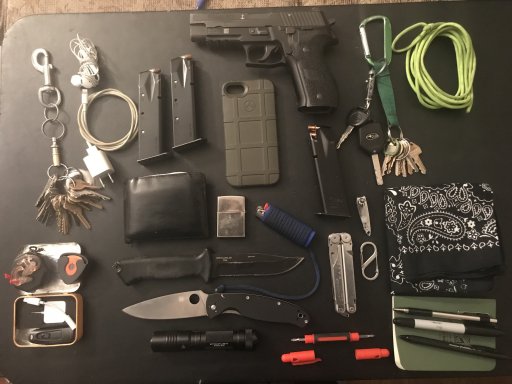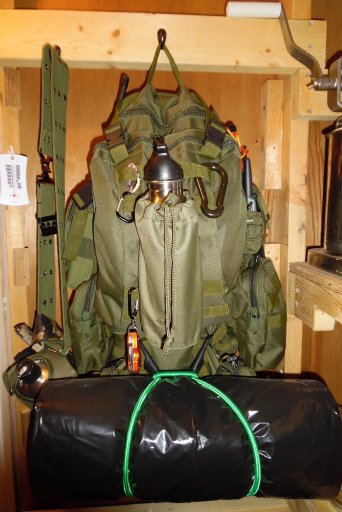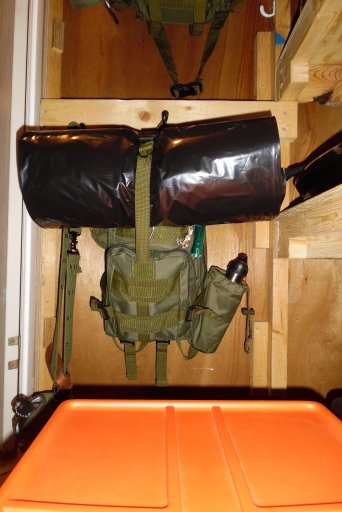
Influencer II
I think most people that are involved in overlanding have a basic understanding and knowledge of outdoor survival, and gear needed when being in remote areas. But as someone relatively new to this forum, I’m learning a lot of new things, and feel like it’s a great resource for those who are less familiar, or have less experience outdoors. So I thought a basic primer on wilderness survival, and some basic gear would be beneficial.
I’m not an expert, by any stretch, but I spend a lot of time in the woods, and have spent a lot of time reading and learning what I can about self reliance and survival.
So here’s a basic break down of things I think everyone should know before heading into the woods, and a simple kit of things you should take with you. Every situation is different, but there are a few guidelines that apply to everything from an afternoon hike to a 2 month expedition.
The more you know, the less you have to carry.
Remember the Rule of 3s. The average human can survive:
Water - Carry a water bottle, and some way to purify any water you may collect. Obviously you should pack water, even for a short hike. But if the trip takes longer than expected, or you get lost or stranded, some way to get and clean water is an absolute necessity. For longer trips roughly a gallon per person, per day is recommended.
What are your options?
Fire - A big part of comfort and security for shelter is fire. Fire is not optional to me in a survival situation. Can you survive without it? Absolutely, but it will be easier if you can make a fire for signaling, warmth, boiling water, light, cooking food (if you have it, or can acquire it). A couple Bic lighters make for a lot of peace of mind. I also carry a ferro rod to make sparks with my knife if the lighters get lost, or fail. (Always be responsible with fire, and make sure to clean up when you are leaving the area)
Which brings me to two other points. The first, Two is one, one is none. Gear will fail you when it’s least convenient. Have a backup for things that are necessary as much as is feasible.
The second, ALWAYS have a knife. The style is up to you, and I’ll go over some pros and cons of several, but the important lesson is you should always have a good knife with you.
Knives:
Fixed Blade - A personal favorite of mine and many outdoor and survival enthusiasts. A full tang (meaning the blade and handle are all one piece of steel) fixed blade knife is one of the most versatile and reliable tools you can carry in the woods. I carry a Gerber Prodigy every day on my belt, but I understand not everyone is in the position to do this. I also have a number of Morakniv knives that have been part of my EDC kit and remain in most of my survival bags. The are inexpensive, and while not full tang, are pretty robust. I haven’t been able to damage any of mine yet, and I’ve abused them pretty hard. If you are assembling a bag to take into the woods, a fixed blade knife is a great addition.
Locking Folding Blade - Probably one of the more popular options, at least in recent years. I’ve seen many more people carrying a small folding knife with a locking blade. I always have one on me, and usually a spare somewhere close. Lately I’ve been carrying a Spiderco that’s almost as big as my Gerber fixed blade, but for about 2 years prior to that I carried an Ozark Trail $4 folder from Walmart. Yep, $4. I wasn’t kidding when I said good didn’t have to mean expensive. I bought the $4 OT knife with the express intention of torture testing it in the real world to see what it would do. 2 years of daily use at my jobs and half a dozen camping and hunting trips and it has earned a place in my survival kit permanently. Not all cheap knives are created equal, but I can say the one I have is pretty amazing. I also have a few Gerber paraframe folders that I will trust until my last breath.
Multitool - Two schools of thought here. Leatherman or Swiss Army.
Leatherman (Gerber, SOG, etc.) style multitools are a little bigger, but tend to be a bit more robust and safer in my opinion. The blades usually lock into place, something I’ll cover more in depth in the next section. I carry a Leatherman Wave, but have owned a number of brands, most of which are comparable. Even the $15 Kobalt has not let me down yet.
Swiss Army knives are very popular, and for good reason. They are small, have a number of tools, are generally well made, and pretty inexpensive. I have carried them in the past, but have stopped keeping one on me daily for a few reasons. First, I always have my Leatherman, so a lot of the extra functions are covered. Secondly, the blades don’t lock open. Why is that a concern? Have you ever closed a very sharp knife on your fingers while trying to work on something? Now think about a survival scenario when the elements, fatigue, and stress are all making you less coordinated. They are great tools, and certainly better than not having a knife, but for me personally they are not my first choice.
First Aid Kit - This is entirely dependent on you, your travel plans, and your level of knowledge of how to use the things in your kit. I can say for sure that most first aid kits that come prepackaged are incomplete at best, and a waste of money at worst. You can find decent kits, just tailor them to your needs before sending them out in the field. The bare necessities for my kit are
Light - I have a hard time seeing in the dark. I also feel a lot safer when I can see what’s around me at night for security reasons. For those reasons I always carry a flashlight. Most of my kits have a headlamp for hiking, camp tasks, or any other reasons I need to have both hands free, but there is always a flashlight on my person. You would be amazed how often it comes in handy in a day. Glow sticks are another inexpensive solution to low level lighting that lasts a long time. I keep a few in my kits for small camp tasks, and as markers if I were to get lost.
Bandana - You know the one. Usually red, paisley pattern, some regions call it a handkerchief. The amount of things you can use these little squares of cotton for are amazing. So many in fact that I’m not even going to attempt to list many. Face covering/primitive dust mask, water filter (for sediment and debris, still need a proper filter or purification system), wound covering, soak in water and tie around your neck to keep cool, wear on your head to keep sweat out of your face and bugs out of your hair. The list is endless. They weigh nothing, take up little space, and cost $1 or less, why don’t you have one already?
Signaling - Yelling takes energy, and isn’t that loud. A whistle doesn’t weigh much, and can be heard much farther away. Signal mirrors are good to have in remote areas where a plane or helicopter may be your only chance of rescue. 3 is a magic number. Three blasts of a whistle, three shots of a firearm, three fires placed in a triangle pattern. These are all signs of distress in most of the world. S.O.S. in Morse code is 3 dashes, 3 dots, 3 dashes. (- - - . . . - - -)
General knowledge that may be helpful:
I’m not an expert, by any stretch, but I spend a lot of time in the woods, and have spent a lot of time reading and learning what I can about self reliance and survival.
So here’s a basic break down of things I think everyone should know before heading into the woods, and a simple kit of things you should take with you. Every situation is different, but there are a few guidelines that apply to everything from an afternoon hike to a 2 month expedition.
The more you know, the less you have to carry.
Remember the Rule of 3s. The average human can survive:
- 3 minutes without air
- 3 hours without shelter (in extreme environments)
- 3 days without water
- 3 weeks without food.
Water - Carry a water bottle, and some way to purify any water you may collect. Obviously you should pack water, even for a short hike. But if the trip takes longer than expected, or you get lost or stranded, some way to get and clean water is an absolute necessity. For longer trips roughly a gallon per person, per day is recommended.
What are your options?
- Water purification tabs - I haven’t used these, and they do have a shelf life, but some people swear by them.
- Water filter/straw - There are a slew of companies that make very compact and lightweight water filters. This is what you’ll find in every outdoor kit I have.
- Boiling - Tried and true, if you have a metal container and a way to make it hot, you can boil water to make it safe to drink.
- Rain water - Not very reliable, but always an option if you can collect it. I don’t like leaving things to chance personally
- Ultraviolet light - I don’t know much about this one, but it’s out there. I will update with more info once I get a chance to try one out.
Fire - A big part of comfort and security for shelter is fire. Fire is not optional to me in a survival situation. Can you survive without it? Absolutely, but it will be easier if you can make a fire for signaling, warmth, boiling water, light, cooking food (if you have it, or can acquire it). A couple Bic lighters make for a lot of peace of mind. I also carry a ferro rod to make sparks with my knife if the lighters get lost, or fail. (Always be responsible with fire, and make sure to clean up when you are leaving the area)
Which brings me to two other points. The first, Two is one, one is none. Gear will fail you when it’s least convenient. Have a backup for things that are necessary as much as is feasible.
The second, ALWAYS have a knife. The style is up to you, and I’ll go over some pros and cons of several, but the important lesson is you should always have a good knife with you.
Knives:
Fixed Blade - A personal favorite of mine and many outdoor and survival enthusiasts. A full tang (meaning the blade and handle are all one piece of steel) fixed blade knife is one of the most versatile and reliable tools you can carry in the woods. I carry a Gerber Prodigy every day on my belt, but I understand not everyone is in the position to do this. I also have a number of Morakniv knives that have been part of my EDC kit and remain in most of my survival bags. The are inexpensive, and while not full tang, are pretty robust. I haven’t been able to damage any of mine yet, and I’ve abused them pretty hard. If you are assembling a bag to take into the woods, a fixed blade knife is a great addition.
Locking Folding Blade - Probably one of the more popular options, at least in recent years. I’ve seen many more people carrying a small folding knife with a locking blade. I always have one on me, and usually a spare somewhere close. Lately I’ve been carrying a Spiderco that’s almost as big as my Gerber fixed blade, but for about 2 years prior to that I carried an Ozark Trail $4 folder from Walmart. Yep, $4. I wasn’t kidding when I said good didn’t have to mean expensive. I bought the $4 OT knife with the express intention of torture testing it in the real world to see what it would do. 2 years of daily use at my jobs and half a dozen camping and hunting trips and it has earned a place in my survival kit permanently. Not all cheap knives are created equal, but I can say the one I have is pretty amazing. I also have a few Gerber paraframe folders that I will trust until my last breath.
Multitool - Two schools of thought here. Leatherman or Swiss Army.
Leatherman (Gerber, SOG, etc.) style multitools are a little bigger, but tend to be a bit more robust and safer in my opinion. The blades usually lock into place, something I’ll cover more in depth in the next section. I carry a Leatherman Wave, but have owned a number of brands, most of which are comparable. Even the $15 Kobalt has not let me down yet.
Swiss Army knives are very popular, and for good reason. They are small, have a number of tools, are generally well made, and pretty inexpensive. I have carried them in the past, but have stopped keeping one on me daily for a few reasons. First, I always have my Leatherman, so a lot of the extra functions are covered. Secondly, the blades don’t lock open. Why is that a concern? Have you ever closed a very sharp knife on your fingers while trying to work on something? Now think about a survival scenario when the elements, fatigue, and stress are all making you less coordinated. They are great tools, and certainly better than not having a knife, but for me personally they are not my first choice.
First Aid Kit - This is entirely dependent on you, your travel plans, and your level of knowledge of how to use the things in your kit. I can say for sure that most first aid kits that come prepackaged are incomplete at best, and a waste of money at worst. You can find decent kits, just tailor them to your needs before sending them out in the field. The bare necessities for my kit are
- Band aids
- Gauze
- Alcohol wipes
- ACE wrap
- Pain reliever
- A few doses of any prescribed medication
- Gloves, in case you are treating someone else
Light - I have a hard time seeing in the dark. I also feel a lot safer when I can see what’s around me at night for security reasons. For those reasons I always carry a flashlight. Most of my kits have a headlamp for hiking, camp tasks, or any other reasons I need to have both hands free, but there is always a flashlight on my person. You would be amazed how often it comes in handy in a day. Glow sticks are another inexpensive solution to low level lighting that lasts a long time. I keep a few in my kits for small camp tasks, and as markers if I were to get lost.
Bandana - You know the one. Usually red, paisley pattern, some regions call it a handkerchief. The amount of things you can use these little squares of cotton for are amazing. So many in fact that I’m not even going to attempt to list many. Face covering/primitive dust mask, water filter (for sediment and debris, still need a proper filter or purification system), wound covering, soak in water and tie around your neck to keep cool, wear on your head to keep sweat out of your face and bugs out of your hair. The list is endless. They weigh nothing, take up little space, and cost $1 or less, why don’t you have one already?
Signaling - Yelling takes energy, and isn’t that loud. A whistle doesn’t weigh much, and can be heard much farther away. Signal mirrors are good to have in remote areas where a plane or helicopter may be your only chance of rescue. 3 is a magic number. Three blasts of a whistle, three shots of a firearm, three fires placed in a triangle pattern. These are all signs of distress in most of the world. S.O.S. in Morse code is 3 dashes, 3 dots, 3 dashes. (- - - . . . - - -)
General knowledge that may be helpful:
- The sun rises in the east and sets in the west, while the specifics change depending on location and time of year, that will get you a rough bearing. Moss on trees or rocks is not a reliable indicator of direction.
- If you are lost, and someone knows roughly where you are, stop moving, stay put, and find a way to signal rescuers. You may spend more time running away from them if you don’t know where you’re going.
- Always tell someone where you’re heading, and when you plan to return. This is one of the most important things I can mention. Even on a hike in my local state forest which is only a few square miles, I tell someone when I’m out hiking, and keep a small survival kit with me. All it takes is one broken ankle, and some bad weather to turn a day hike into a serious situation.
- Stay hydrated. Food may seem more important, but you need water much more than food.
- Don’t panic. Stop, assess the situation, make a plan, then start doing what needs to be done. It’s easy to lose your head and get yourself in more trouble than you would think.
- Know when to admit something isn’t right. We all want to be confident we are right. But no one gets lost in one decision. Usually it’s a series of choices that lead to problems.
- If you are not 100% sure you know what a plant is, don’t eat it, or even touch it if you can avoid it. Most things that are edible in nature have a poisonous counterpart that looks very similar.
- Stay positive. Nearly anyone who has lived through a survival situation will attest that a positive mindset and good attitude will get you through nearly anything. Giving up is not an option, and you can make it through anything if you try hard enough.










